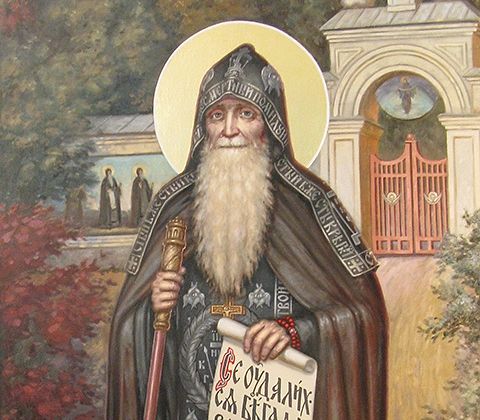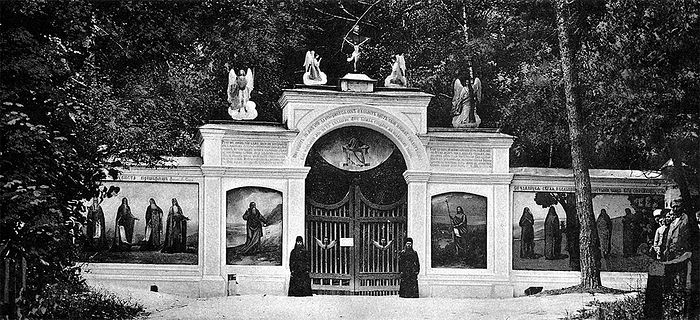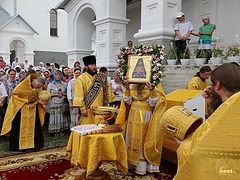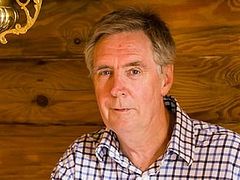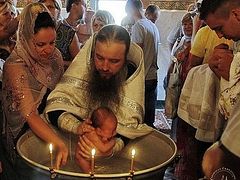Hieroschemamonk Longin (in the world Leonty Pavlovich Griftsov) was born in June 1798 in the city of Ryazan. He came from a priestly family and graduated from the Ryazan Theological Seminary. In his parent’s house, Leonty received a strong spiritual upbringing, and in his mother, whom he lovingly remembered until his old age, he had an image of asceticism. Thanks to her blessed influence, while still in seminary, Leonty felt drawn to monasticism and dreamed of entering a monastery.
Upon graduating seminary, he began to go through the ranks of civil service rather quickly, got married, bought a house in the city of Ryazan and lived comfortably, but he had no children. Leonty was soon appointed as the prosecutor in the city of Uralsk and moved there with his wife. There he enjoyed esteem in high places, lived openly, and loved to visit and receive guests, which his wife—a capricious and willful woman—especially enjoyed. His wife’s bad temper was the first reason why he returned to the dreams of his youth and began to regret that he hadn’t become a monk. Discord with his wife, vanity, guests, and feasts began to annoy him: He longed for something inexplicable.
He loved reading spiritual books, prayers, and the Church services, and he completely cooled to the world. His Eminence Irenei of Yaroslavl advised him to endure his family fetters, not destroying the union sanctified by the Church, and encouraged him, that if he endures, then the Lord, in ways known only to Him, would free him from the world and lead him to a quiet monastic pier. His wife armed herself against him all the more, harassing him with abuse and ridicule, and Leonty was soon personally convinced of her infidelity. Having resigned, he went to Kiev to venerate the saints of the Caves and there seek advice from the spiritually experienced elder Hieroschemamonk Partheny, who strongly advised him to go to the Svyatogorsk Hermitage without any doubt or hesitation, and to labor there until the end of his life. “There is your place,” the elder told him. “Go there and you will find salvation. The will of God for you is to labor in this monastery, benefiting it with your labors, for which the Mother of God herself, the head of the monastery, will recompense you in the future age.”
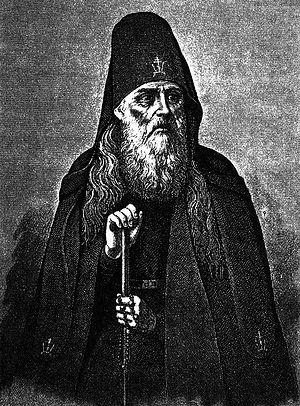 Elder Partheny of the Kiev Caves In 1854, having arrived to the Holy Mountains,[1] he laid all of his money at the feel of Archimandrite Arseny, after the examples of the apostles, to the general monastery funds. No longer a young man, and accustomed to honor and privilege for his service as a former prosecutor and court councilor, he sincerely humbled himself and, alongside the simple novices, he traversed the uneasy path of a new monastic. Appreciating the self-denying podvig of the former prosecutor, Archimandrite Arseny loved him with all his heart, seeing him as someone very useful for the newly-established monastery with his legal knowledge, and began to distinguish him with his trust.
Elder Partheny of the Kiev Caves In 1854, having arrived to the Holy Mountains,[1] he laid all of his money at the feel of Archimandrite Arseny, after the examples of the apostles, to the general monastery funds. No longer a young man, and accustomed to honor and privilege for his service as a former prosecutor and court councilor, he sincerely humbled himself and, alongside the simple novices, he traversed the uneasy path of a new monastic. Appreciating the self-denying podvig of the former prosecutor, Archimandrite Arseny loved him with all his heart, seeing him as someone very useful for the newly-established monastery with his legal knowledge, and began to distinguish him with his trust.
In respect of his years and his good life, he adorned him in the riassa and kamilavka.[2] They started calling him Fr. Leonty in the monastery, although according to his official documents he was still the court councilor Leonty Griftsov. He manifested an ascetic orientation from the very moment he entered Svyatogorsk Monastery; he gradually habituated himself to fasting, to prayer, to wearing a coarse hair shirt on his naked body, to non-possessiveness and contentment with the very least, to unmurmuring obedience and unfeigned humility. He worked tirelessly for the good of the monastery, sparing neither his strength nor health. Fr. Arseny, knowing Leonty’s ascetic direction, appointed him as head of the newly-built Skete on the Holy Place, despite the fact that he was not yet a monk, nor even an official novice.
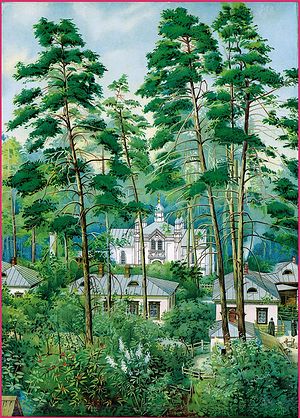 St. Arseny Skete of the Svyatogorsk Lavra His life in the skete was led in squalid conditions, all objects of comfort being carefully expelled from his cell, with monastic simplicity and poverty reigning, even to an extreme extent. He was indefatigable in his prayerful podvig: Guided by the Patristic works, he drew lessons of the art of prayer from them, but, as he himself confessed, the vessel of his soul, once filled with worldly vanity and sinful predilections, was not fully able to accommodate the blessed myrrh of prayer to the extent that it is given to those who have labored in virginity and purity from their youth.
St. Arseny Skete of the Svyatogorsk Lavra His life in the skete was led in squalid conditions, all objects of comfort being carefully expelled from his cell, with monastic simplicity and poverty reigning, even to an extreme extent. He was indefatigable in his prayerful podvig: Guided by the Patristic works, he drew lessons of the art of prayer from them, but, as he himself confessed, the vessel of his soul, once filled with worldly vanity and sinful predilections, was not fully able to accommodate the blessed myrrh of prayer to the extent that it is given to those who have labored in virginity and purity from their youth.
Nevertheless, he diligently labored in prayer and the name of the Lord Jesus Christ was ever on his lips, which he pronounced prayerfully, though drowsy. Concentrated within himself, with gray-haired head drooping downwards, he would often sit among guests, contemplating, or rather soaring somewhere far away, tears often flowing from his eyes without apparent reason. God alone knows what was happening then in the elder’s soul—he didn’t like to talk about it—but his appearance showed that his thoughts were not occupied with worldly, everyday matters. Especially in the company of laymen, the elder would go deep within himself, saying only what needed to be said; his business conversations were always short and circumspect. But to those in whom he saw love for God and the inclination to prayer and Christian piety, he related warmly and could say a word for the good of their souls, giving them council on brotherly love, and he would remember such people long afterwards.
His wife died in 1870; now Leonty could be officially accepted as a novice after nearly twelve years of living in the monastery not only as a novice, but as the head of the skete. In 1871, Leonty was tonsured into the mantia[3] by Archimandrite Herman and given the name Leonid. In 1873, Fr. Leonid was ordained as a hierodeacon in the city of Kharkov in the Church of the Holy Protection Monastery, and seven months later as a hieromonk in the Svyatogorsk Hermitage. The elder zealously began to serve at the altar of the Lord, intensifying his prayerful podvigs, but, decaying in body, diminishing in strength, he was visibly moving towards the sunset of his life.
He tirelessly served the Svyatogorsk skete, still serving as the head and firmly holding onto the reins of management. Thanks to his ability to manage affairs, the skete did not burden the monastery, but even brought it considerable benefit, namely in the commemoration of names in the skete chapel. The elder was an unmercenary with regards to himself personally; from the time of his tonsure as a riassaphore,[4] having forfeited his pension, he lived in complete poverty, using whatever was available from the monastery, that is, humble clothes and shoes, skete food, and a share of tea and sugar. The elder especially loved poverty in terms of clothing, wearing them for a long time, not wanting to flaunt them. A coarse and sharp hair shirt often served as his undergarment, worn on his naked body. The elder would say that this hair shirt was very useful for him, healing him from rheumatism, helping his blood circulate, and serving as a protection from the piercing wind. Concerning the spiritual benefit of the hair shirt, the elder humbly remained silent, although he could have said much in this regard.
With the onset of 1881, Elder Leonid could hardly walk anymore. He was unable to walk through over the hills and through the woods from the skete to the monastery at the abbot’s first call, he couldn’t even stand in church, he couldn’t see anything anymore with one eye, and he could barely hold a pen: His former activities involuntarily ceased. In 1882, Fr. Leonid received the holy schema,[5] being named Longin. He already had no strength to labor as a schema monk in bodily podvigs, but he did not stop going to the Church services until the end of his days. The gift of tears manifested itself in him especially profusely before his repose.
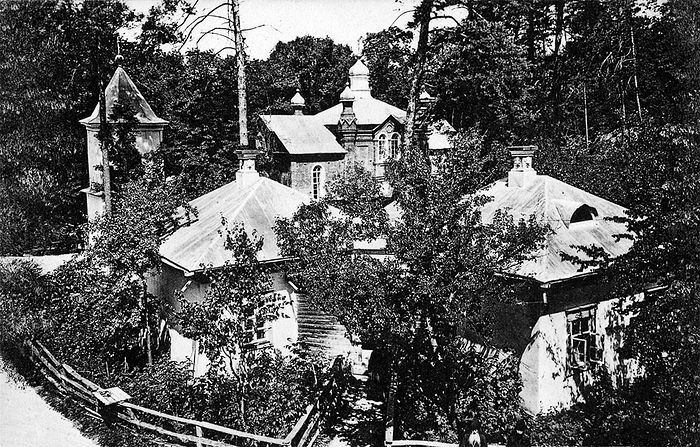 The church and cells of the St. Arseny Skete
The church and cells of the St. Arseny Skete
On July 14/27, 1882, Fr. Longin quietly and peacefully gave his spirit over into the hands of God, having communed of the Holy Mysteries of Christ not long before his exodus.
On July 15, his body was given over to the earth behind the walls of the High Place[6] in the skete church. The grateful Svyatogorsk Monastery and its worthy abbot honored the grave of the elder with a beautiful cast iron monument. Svyatogorsk Monastery lost much in the person of the reposed elder, is greatly indebted to him, and will forever keep his memory with praise, both as a valiant ascetic of piety and as a fervent zealot of its spiritual and physical blessings.
“He was a monk with an outstanding mind and high education,” recalls Ekaterina Zhilinskaya. “In the world he held a prominent post in the Judicial Department, but, having known all the vanity of worldly goods and honors, he came to the Svyatogorsk Hermitage to seek ‘the one thing needful’ in arduous monastic podvigs.”
Having examined the lives, labors, podvigs, miracles, and the people’s veneration of the ascetics of piety who labored in the Holy Mountains of Donetsk, on May 8, 2008, the Holy Synod of the Ukrainian Orthodox Church made the historical decision “to bless the Venerable Hieroschemamonk Longin (Griftsov), among others, for local glorification and veneration as a saint.”
On July 12, 2008, the Ukrainian Orthodox Church included Hieroschemamonk Longin among the venerable fathers of the Synaxis of Svyatogorsk Saints. The Synaxis of Svyatogorsk Saints is commemorated on September 11/24.
At the very beginning of September 2008, following the Church glorification, the abbot of the Svyatogorsk Lavra, Bishop Arseny (Yakovenko), with the brethren, raised the holy relics of St. Longin, which had lain concealed in the skete, to behind the altar of the ruined Church of St. Arseny the Great.
At present, the relics of St. Longin of Svyatogorsk are available for general veneration in the Svyatogorsk Lavra’s Dormition Cathedral.
The memory of St. Longin of Svyatogorsk is commemorated on July 14/27.
Dear brothers and sisters, we ask you to remember in your holy prayers the repose of Paul, the father of St. Longin.

